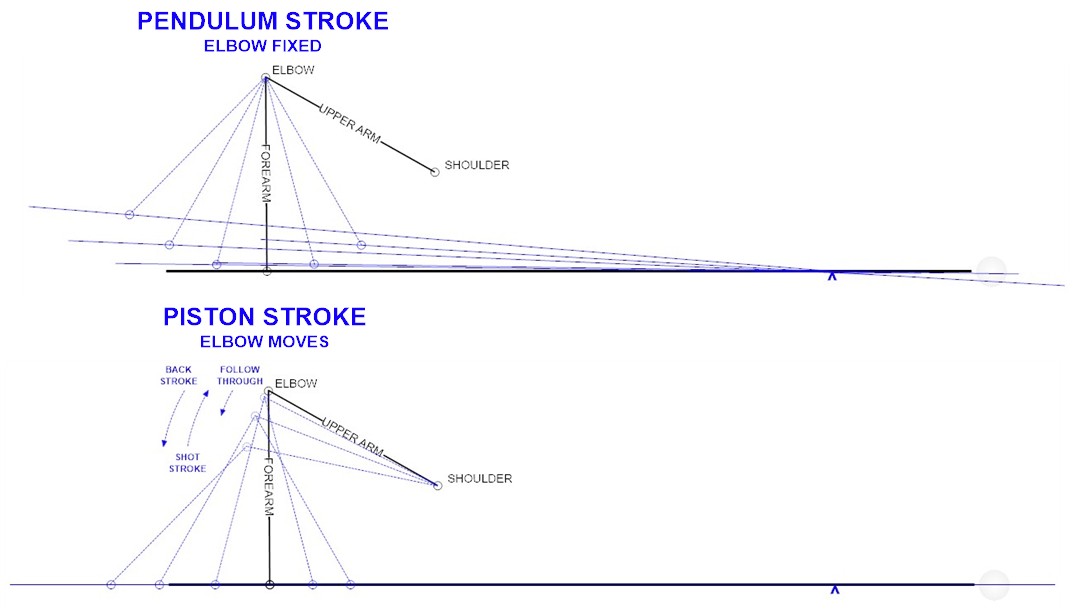What is the difference between a pendulum stroke and a piston stroke?
A “pendulum stroke” is where you keep your upper arm still during the stroke. The only motion is from the elbow down. Some people refer to this as a “pinned elbow” stroke. With a pendulum stroke, the upper arm is considered part of your body, which should remain still during the stroke.
A “piston stroke” (AKA “pump stroke”) is one where you coordinate motion of both the elbow and the shoulder to keep the cue tip moving in a straight line during the entire stroke (just like a piston in the cylinder of an internal-combustion engine). This type of stroke is common among snooker players who guide the cue on the chest and chin during the stroke, forcing the cue to move in a straight line.
A “J” stroke is a combination of a pendulum and piston stroke, where the grip hand follows the pendulum motion on the back swing and forward swing into the ball, and then the grip moves in a straight line (with elbow drop) after CB contact and during follow through. If you trace out the path of the grip hand, it looks like a “J” turned sideways. If done well, this gives the benefits of the pendulum stroke tip contact point accuracy, and the follow through of a piston-stroke, but some people might have trouble with dropping the elbow at the right time and right amount consistently.
Many pros seem to be close to a “J” stroke, but some pros drop their elbow before CB contact, on some shots more than others. Also, some lift the tip after CB contact, especially with follow shots, and some finish with the tip down (with an almost-pendulum-like stroke finish). Some even swoop their stroke on some shots (usually only shots with english), moving the tip sideways during the stroke (before and after CB contact). Some drop their elbow just a little after CB contact on many shots, and some drop their elbow a lot (mostly after CB contact) on most shots. The one thing that can said for sure is that most pros drop their elbow after CB contact, especially with firmer shots. Some seem to do this purposefully; and for others, it just seems like a natural side-effect of the forward momentum of the cue and arm after CB contact.
For more information on the differences and advantages of each type of stroke, see: elbow drop.
For more info and advice, see stroke technique advice and follow through.
from Patrick Johnson (in AZB post):
Here’s a diagram of pendulum vs. piston stroke dynamics. The piston stroke (used by snooker players) has the elbow moving up and down throughout in order to keep the cue level.
With a piston stroke the elbow drops during follow through and, assuming the elbow is above the shoulder as shown, its downward arc takes it farther away from the CB, actually slowing the stroke’s forward motion.

With a pendumlum stroke, the tip moves up and down during the stroke. Does that have any negative effects?
No. With a pure pendulum stroke into the CB, the tip returns to the exact spot aimed at on the CB, assuming the tip isn’t too far from the CB at address. Also, the motion of the tip is very straight both a few inches before contact and a few inches after contact. For illustrations and example numbers, see:
TP B.18 – Pendulum Stroke Cue Tip Trajectory
Dr. Dave keeps this site commercial free, with no ads. If you appreciate the free resources, please consider making a one-time or monthly donation to show your support:
